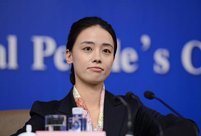 Ballerinas anywhere but onstage
Ballerinas anywhere but onstage
 Top 10 safest airlines in the world
Top 10 safest airlines in the world
 Top 10 most popular instant messaging apps in the world
Top 10 most popular instant messaging apps in the world
 Inspiring shadow images of Chinese army
Inspiring shadow images of Chinese army
 Models shine Xinjiang auto show
Models shine Xinjiang auto show
 From laid-off worker to int'l referee in bodybuilding
From laid-off worker to int'l referee in bodybuilding
 Selected photos of 'two sessions'
Selected photos of 'two sessions'
 Most unusual taxis around the world
Most unusual taxis around the world
 Bridge Worship Festival in Taijiang, SW China
Bridge Worship Festival in Taijiang, SW China
 |
| Liu Shijin, deputy director of the Development Research Center of the State Council, delivers a speech at the ”2014 Global Economic Outlook” session of the “ China Development Forum 2014” in Beijing, March 22, 2014. (Photo/ ce.cn) |
Beijing, March 22 (People's Daily Online) -- China faces three major challenges in its economic transition: controlling the fiscal and financial risks, enhancing the efficiency of the non-tradable sectors, and looking for new growth areas, said Chinese official Liu Shijin in Beijing today.
Liu Shijin, deputy director of the Development Research Center of the State Council, delivered a speech at the ”2014 Global Economic Outlook” session of the “ China Development Forum 2014”.
The China Development Forum 2014 (CDF2014) - approved by the State Council and sponsored by the Development Research Center of the State Council –lasts from March 22 to 24 at the Diaoyutai State Guesthouse in Beijing. The forum, with the theme "China: To Comprehensively Deepen Reform", focuses on crucial issues including new-type urbanization, reform of the fiscal and taxation system, construction of a social security system and a new system of open economy, and state-owned enterprises (SOE) reform.
Liu points out that the current fiscal and financial risks are mainly in areas including local financing platform, real estate industry, overcapacity industries, and shadow banks. They intertwine with each other and form a risk transfer loop.
Compared with the developed economies, China’s non-tradable sectors have lower efficiencies, especially in the administrative monopoly sectors, infrastructure and basic industries. The resource allocation distortion problems are prominent. Once these distortions are corrected, the efficiency of China's non-tradable sectors will have much room for improvement.
Liu says that China needs to promote various forms of innovation when seeking new growth areas. “These areas can be discovered through potential needs in educational, medical, and cultural industries, or be developed through the new technology like online shopping and photovoltaic power generation, or be triggered through responses with prominent problems like green industries including energy saving, water saving, clean energy, emissions reduction.”
To accelerate innovation is a more important way in exploring new growth areas, Liu says. In recent years, China has seen a tendency of resource concentration in regional innovations, which has enhanced the development in innovative regions and cities. As China’s distance with the global technology shortens, China will gradually change its role as a technology imitator or follower. There is an increasing possibility that China will keep pace with forerunners or even be a leading pioneer in some areas.
The article is edited and translated from《刘世锦:中国经济转型期面临三大挑战》, source: People.cn
 Female journalists at 'two sessions'
Female journalists at 'two sessions' Interpreters serving 'two sessions'
Interpreters serving 'two sessions' Female SWAT team in Chongqing
Female SWAT team in Chongqing Top 10 safest airlines in the world
Top 10 safest airlines in the world Old photos of Anti-Japanese War
Old photos of Anti-Japanese War Mysterious 'Dolan Tribe' in Xinjiang
Mysterious 'Dolan Tribe' in Xinjiang A bite of Luoping County
A bite of Luoping County This is Shanghai
This is Shanghai Chinese airborne troops complete parachute training in various training bases
Chinese airborne troops complete parachute training in various training bases Ballerinas anywhere but onstage
Ballerinas anywhere but onstage Most unusual taxis around the world
Most unusual taxis around the world Micro-expression at 'two sessions'
Micro-expression at 'two sessions' Bridge Worship Festival in Taijiang, SW China
Bridge Worship Festival in Taijiang, SW China Hollywood documentary brings Diaoyu Islands truth to new audience
Hollywood documentary brings Diaoyu Islands truth to new audience Miss HK and actresses shine at flower show
Miss HK and actresses shine at flower showDay|Week|Month